Brown Patch Fungus | Brown Patch Fungus Treatment and Prevention
Your lawn is not just a patch of grass; it’s the central feature of many gardens and demonstrates the beauty of nature right at your doorstep. However, this lush green canvas can quickly turn into a nightmare with the invasion of the Brown Patch Fungus. This disease, scientifically known as Rhizoctonia solani, has a knack for turning vibrant green blades into a dreary brown in no time.
The sight of your beautiful turf succumbing to this pest is every gardener’s dread. Understanding the onset of Brown Patch is crucial as it predominantly targets cool-season grasses like tall fescue and perennial ryegrass, although no turf is truly safe.
Armed with the right knowledge and timely intervention, the battle against Brown Patch Fungus is winnable. Below, we will equip you with the essential know-how to identify the early signs of Brown Patch, understand its behavior, and adopt effective preventive and treatment measures.
What Is Brown Patch Lawn Disease?
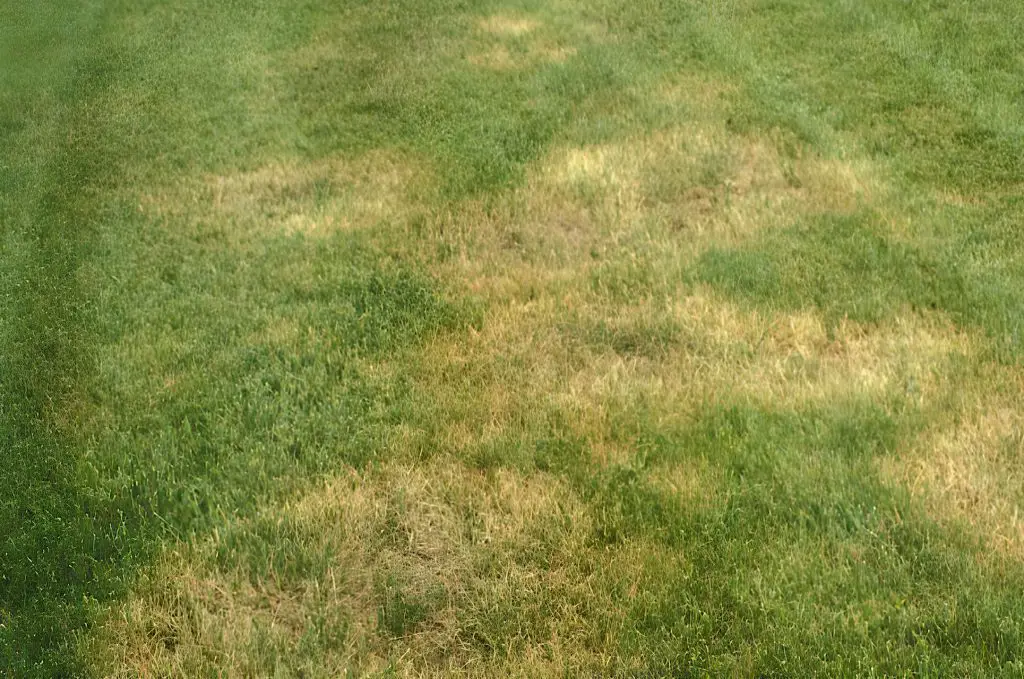
Brown patch, is caused by Rhizoctonia solani pathogen and is a disease that is common in warm, moist conditions. It often occurs in two forms: Circular patches that grow larger over time, and irregular patches of brown grass or that can grow up to 18 inches or 46 centimeters in diameter. The disease causes the grass to turn straw-colored, before turning brown, and the infected area may eventually die.
The attack usually commences with the arrival of warm, humid weather, creating a conducive environment for the fungus to thrive. The key to averting the crisis lies in early identification. Your first clues are often small, circular patches that seem to expand over time, engulfing your lawn in a brownish hue. Ignorance could lead to a scenario where your lawn resembles a barren land rather than the lush paradise you once prided on.
How to Tell that Your Lawn Has Brown Patch?
It is possible to see a variety of brown patch disease symptoms, but the most common is a light yellowish-brown patch of grass that is about round or rectangular in shape. The infected areas can range from just a few inches to several feet in diameter. As the damage spreads, it is possible for the infected patches to merge. In severe attacks, large sections of grass may be thinned and die without obvious initial circular patches ever forming if the conditions are particularly suitable for disease transmission.
The damaged region will eventually become a darker brown. Donut-shaped patches of turfgrass are common in areas where the grass partially recovers at the center of an infected area. During the fungus’ incubation period, grass blades become infected and rot.
Which Grasses Does Brown Patch Affect?
Brown patch can be found on almost all types of grass although some species are more resilient than others. It is very common in cool-season grasses, but ryegrass and tall fescue are particularly vulnerable to its effects. St. Augustine grass, Bermuda, and zoysiagrass are all also susceptible to Brown patch.
Affected mature turfgrass is usually able to recover, while tall fescue lawns that are less than a year old may be completely wiped out. Compared to all other tall fescue cultivars, Kentucky-31 is more resistant to Brown patch.
Climatic Conditions in Which Brown Patch Fungus Thrives
Brown patch lawn disease is most common in June, July, and August. Brown patch lawn disease can spread quickly, destroying large areas of lawn.
It thrives in conditions where temperatures are elevated above 70° F, high humidity levels, and surface wetness. Your lawn will be more likely to develop brown patch lawn disease if your lawn is under stress.
Brown Disease Cycle
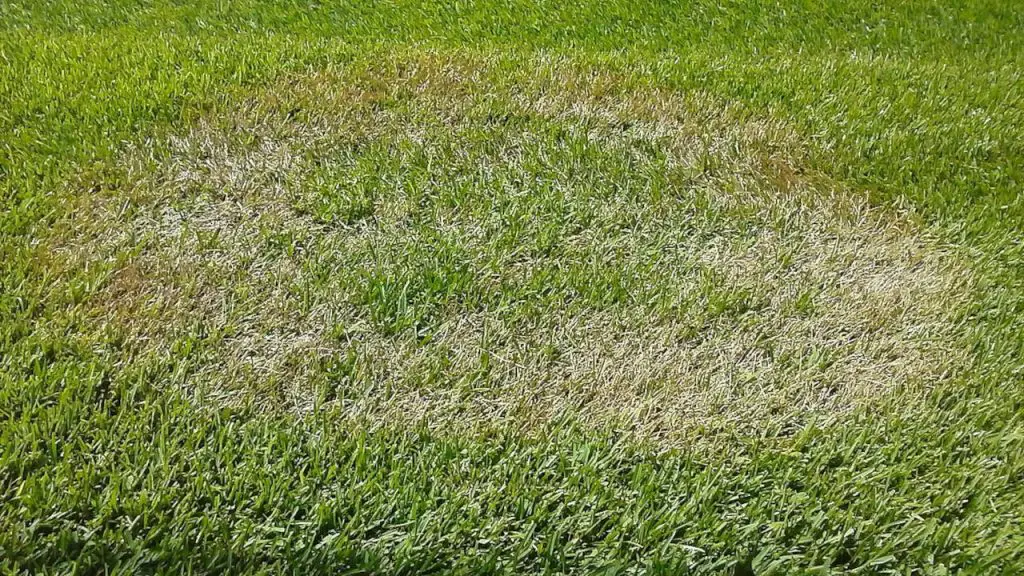
Brown patch’s causative fungus overwinters as sclerotia, resting bodies found in soil or diseased grass tissue. When there is no vulnerable grass host, Sclerotia may live for years in the soil.
Sclerotia germinate and form mycelium that infects the grass blade and stem tissues triggering when circumstances are favorable. These are usually as a result of high temperatures, humidity, and surface wetness, the mycelium on plants may infect new tissues and cause sick patches to appear.
Prevention and Treatment of Brown Patch
Because brown patch is so difficult to eradicate, cultural control and prevention measures should be employed as part of your lawn care program. Getting rid of brown patch is all about understanding the nature of the disease. Fundamental to this appreciating that the fungus can reside in your soil even if there are no visible signs of it in the grass. This is because Brown patch can lie dormant in the winter, but will appear again when the weather warms and the lawn begins to grow again.
The brown patch fungus attacks when the circumstances are just perfect, making preventative actions all the more crucial. It’s important to treat your lawn at the first sign of brown patch lawn disease. The sooner you treat the disease, the more effective your treatment will be.
Crabgrass is one of the most common lawn pests, and it’s one of the most common causes of brown patch lawn disease. Watch out for crabgrass and treat it as soon as it appears as it can spread rapidly.
If your lawn has large dead areas, you may need to reseed. Reseeding your lawn will help your lawn recover from the Brown patch fungus. When reseeding look to use a more resilient grass type and this will help your lawn stay healthy in the future.
Preventive Measures & Cultural Control (Non-Chemical)
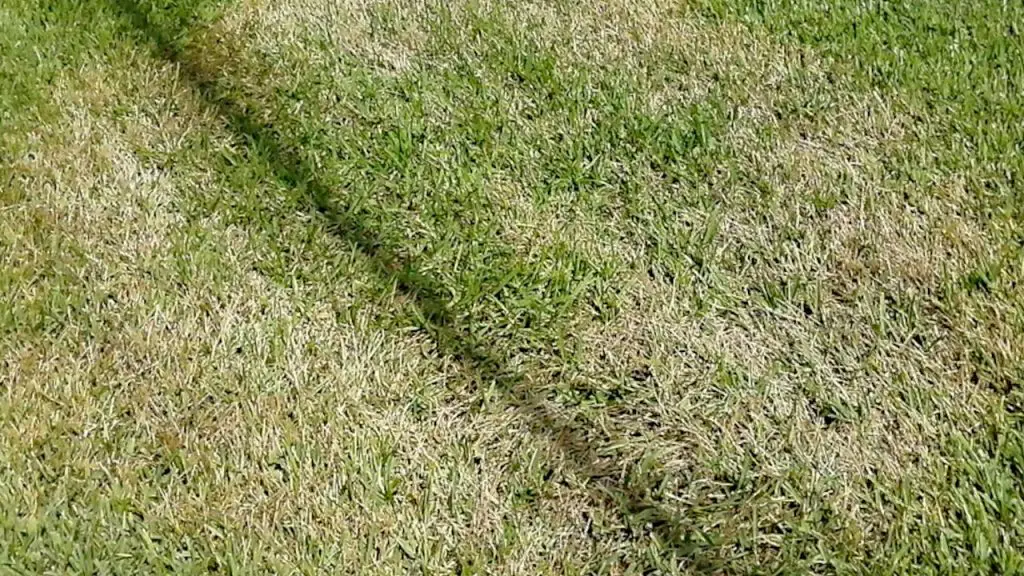
Preventing Brown Patch Fungus from invading your lawn requires a blend of vigilant monitoring and proactive lawn care practices, combined with effective lawn fungus control. Here are strategic steps to keep your garden sanctuary free from this fungal foe:
Nutrient Management:
Lawns need fertilizer to thrive because of the nutrients that they contain. Too much fertilizer though can hurt your lawn, but too little fertilizer won’t help your lawn recover and can help some lawn diseases. It is generally advisable to fertilize your lawn about 4-6 times per year.
- Avoid excessive nitrogen fertilizer applications, especially during late spring and summer for cool-season grasses, and in mid-to-late fall or early spring for warm-season grasses.
- Opt for slow-release fertilizers that provide a steady nutrient supply without overstimulating lush growth, which the fungus favors.
If the pH level of your soil is less than 6.0, Brown patch may be more acute. In addition, make sure that the potassium and calcium levels in the soil are maintained at good levels.
Watering Wisely:
Watering your lawn to help it recover from the lawn disease. It is better to water your lawn deeply, but less frequently. This will help ensure that your lawn gets enough water, without overwatering.
- Water your lawn early in the morning to allow the grass to dry before evening.
- Avoid over-watering. Ensure your lawn receives 1 to 1.5 inches of water per week, including rainfall.
Mowing and Thatching:
Mow your lawn regularly to encourage your lawn to grow. Mowing your lawn properly and regularly will also help prevent Brown patch from taking hold. When mowing, remove no more than 1/3 of the length of your grass each mow and look to maintain a lawn height of between 1½ to 2 inches. Mowing your lawn in this manner will also help your lawn recover from the lawn disease.
Too much thatch on your lawn can also be a problem. Thatch can suffocate your lawn. If you have too much thatch, your lawn will be more likely to suffer from Brown patch and other lawn diseases. Scarifying your lawn in the autumn will remove excess thatch from your lawn.
- Keep your lawn mowed at the recommended height for your specific grass type to promote air circulation and reduce leaf wetness.
- Dethatch your lawn regularly to prevent a buildup of organic matter which can harbor the fungus.
Soil and Drainage:
- Test your soil and amend it to ensure good soil drainage and a balanced pH.
- Aerate your lawn at least once a year to alleviate soil compaction, promoting better drainage.
Remove dead or diseased grass.
When your lawn is under attack, you’ll need to remove some of the damage. Removing the dead or diseased grass will help your lawn recover more quickly.
Avoid spreading the disease
It is essential that if part of your lawn is infected you prevent the infection from spreading to other regions. It is best to remove clippings when mowing, especially if the weather is warm and damp. After the morning dew has dried, mow the grass and pay special attention to any infected areas.
Ensure that you thoroughly clean any garden equipment that you have used on an infected area and if you use a lawn care company make sure their equipment to cleaned before use on your lawns. This will help avoid any cross-contamination.
Control Weeds, Lawn Pests, and Insects.
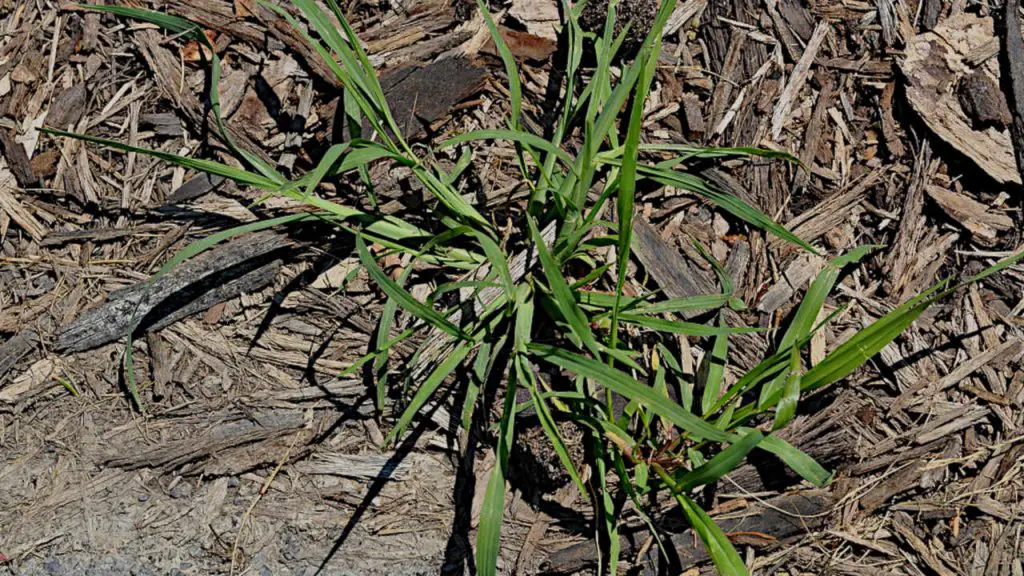
Crabgrass is one of the most common invasive weeds in lawns, and it’s one of the most common contributing factors of brown patch lawn disease. Watch out for crabgrass and treat it as soon as it appears as it can spread rapidly.
Lawns under any form of stress are more susceptible to brown patch infections. Stress can be caused by improper watering, mowing, and fertilizing as discussed above. Lawns can also be put under stress by insect infestations, such as chinch bugs or ants. It is important to deal with these if you become aware of a problem.
Reseed the Lawn
If your lawn has large dead areas, you may need to reseed. Reseeding your lawn will help your lawn recover from the Brown patch fungus. When reseeding look to use a more resilient grass type and this will help your lawn stay healthy in the future.
Disease-Resistant Varieties:
- Consider overseeding with disease-resistant varieties of turfgrass to reduce the susceptibility of your lawn to Brown Patch Fungus.
| Grass Type | Recommended Mowing Height | Disease Resistance Level |
|---|---|---|
| Tall Fescue | 3-4 inches | Moderate |
| Perennial Ryegrass | 2-3 inches | Moderate |
| Kentucky Bluegrass | 2-3 inches | High |
| Bermuda Grass | 1-2 inches | High |
By employing these preventive measures you can significantly diminish the risk of Brown Patch Fungus invading your lawn, ensuring it remains a vibrant and enjoyable space.
Treating Brown Patch with Fungicide – (Chemical Treatment)
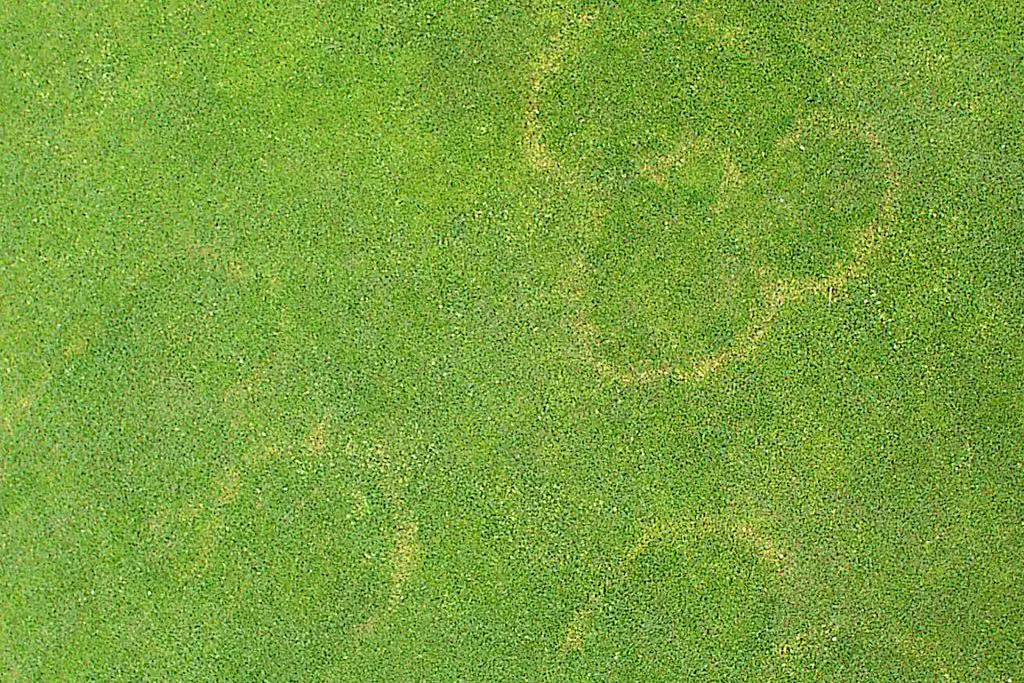
Once you have Brown patch you may well need to use a chemical solution to completely eradicate the problem. However, fungicides can be difficult to rely upon for controlling Brown Patch in the home lawn, but regular applications can vastly improve the lawn’s appearance
When fungicides are administered, the goal is generally to treat an existing problem, although they can and arguably should, also be used on a preventative basis as part of your cultural management. It is important to treat brown patch symptoms with fungicides as soon as they appear.
Preventatively, fungicides should be applied to turfgrass like tall fescue in the spring and early summer Curative treatments may need to be made regularly during the summer if rainfall is frequent Resistance to the fungicide by the Brown Patch fungi will develop from continued exclusive use of products containing only azoxystrobin or fluoxastrobin1. Always alternate between these fungicides with one with a different active ingredient. Alternatively, use a fungicide which contains 2 active ingredient
It should be noted that because cool-season grasses grow slowly in hot weather, they may not be able to recover from the harm they sustained under these circumstances.
The type of fungicide you use will be largely determined by what is readily available to you and how you plan to use it. Many fungicides need to be applied to the lawn at least twice a month but be sure to verify the label and directions before usage to ensure appropriate and effective administration.
| Fungicide | Application Rate | Frequency |
|---|---|---|
| Azoxystrobin | 0.2-0.4 fl oz/1000 sq ft | Every 28 days |
| Propiconazole | 0.2-0.4 fl oz/1000 sq ft | Every 14-21 days |
| Thiophanate-methyl | 0.2-0.4 fl oz/1000 sq ft | Every 14-21 days |
| Flutolanil | 0.2-0.4 fl oz/1000 sq ft | Every 14-21 days |
| Headway G | 1.5-3 fl oz/1000 sq ft | Every 14-28 days |
| Pillar G | 1.5-3 fl oz/1000 sq ft | Every 14-28 days |
| Dithiocarbamates | See Manufactures instructions | Every 14 days |
Note that fungicides should be considered as a last option, and a professional lawn care service should be contracted for the best results regarding product selection and timing,
Summary | Preventing and Eradicating Brown Patch Fungus
The best defense against Brown patch lawn disease is a healthy lawn. A lawn that’s well-fed, well-watered, and free from lawn pests and lawn diseases will be less susceptible to lawn diseases.
Make sure you give your lawn the nutrients it needs, avoid watering your lawn during the middle of the day, and ensure your lawn is not under stress.
As Brown patch fungus spreads rapidly in hot, moist conditions it is during these periods that you should be especially attentive. If it takes hold it can spread rapidly and also infect the roots and crowns of other plants, such as vegetables and flowers.
If Brown patch lawn disease has already taken hold, you should look to take the problem as soon as possible using a fungicide. It may well be advisable to employ a preventive fungicide spray in locations known to produce extensive lawn damage is the best option.
Videos
References
- Clemson University: Brown Patch and Large Patch Diseases of Lawns
